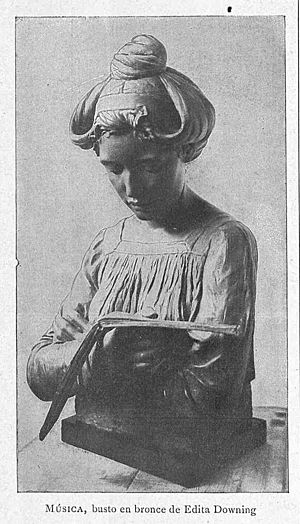Edith Downing facts for kids
Quick facts for kids
Edith Downing
|
|
|---|---|

Edith Downing at work.
|
|
| Born |
Edith Elizabeth Downing
1857 Cardiff, Wales
|
| Died | 3 October 1931 (aged 73–74) Surrey, England
|
| Education | South Kensington School of Art, Slade School of Art |
| Known for | Sculpture and women's suffrage |
Edith Elizabeth Downing (born January 1857 – died October 3, 1931) was a talented British artist. She was a sculptor and also a strong supporter of women's right to vote, known as a suffragette.
Contents
Edith Downing's Life Story
Edith Elizabeth Downing was born in Cardiff, Wales, in January 1857. She grew up with two sisters and a brother. Her sister Mary also became an artist. Her other sister, Caroline Lowder Downing, joined Edith in fighting for women's rights.
After studying at Cheltenham College, Edith lived and worked in Chelsea for most of her life. She passed away in October 1931 in Surrey, England.
Her Artistic Career
Edith Downing started her art training at the South Kensington School of Art. Later, she studied at the Slade School of Art from 1892 to 1893. She was mainly known for her sculptures. She made busts (sculptures of heads and shoulders) and full figures using bronze and marble.
But Edith didn't just sculpt! She also painted watercolours and created decorative panels. Her artwork was first shown at the famous Royal Academy in 1891. She continued to show her pieces there regularly until the early 1900s.
Where Her Art Was Shown
Edith also exhibited her work at other important places. These included the Royal Glasgow Institute and the Paris Salon. She was also a member of the South Wales Art Society.
You can see some of Edith Downing's sculptures today. The National Museum of Wales in Cardiff has several of her works. One is a life-size bronze figure called 'Avarice'. Another important piece is an altarpiece made of alabaster. This piece is a memorial in St. Peter's Church in Wormbridge, England.
Art for a Cause
Edith Downing used her artistic skills to help the suffragette movement. This was a movement that fought for women to have the right to vote. She worked with another artist, Marion Wallace-Dunlop. Together, they organized exciting public parades. Edith also sold her art to raise money for the cause. For example, she made small statues of important suffragette leaders like Christabel Pankhurst and Annie Kenney.
Fighting for Women's Rights
Edith Downing joined the Central Society for Women's Suffrage in 1903. By 1908, she felt that quiet work wasn't enough. So, she joined the more active Women's Social and Political Union (WSPU). Her sister Caroline joined too.
Famous Suffragette Parades
In June 1910, Edith and Marion Wallace-Dunlop created a 'Prisoners Tableau'. This was a special display for a WSPU parade called 'Prison to Citizenship'. The next year, they worked together on the 'Women's Coronation Procession'. This large parade was led by Flora Drummond on horseback. It included 700 women dressed in white. They represented suffragette prisoners.
Taking Action
In November 1911, Edith took part in several protests. During one protest in Parliament Square, there were clashes with police. Later that month, she broke a window at Somerset House. For this, she was sent to jail for a week.
She was arrested again on March 1, 1912. This time, she threw a stone through a window of an art shop in Regent Street. This was part of a large WSPU protest where about 200 activists, including her sister Caroline, broke windows in the West End.
In Prison for the Cause
After this arrest, Edith was sent to Holloway Prison. There, she joined other suffragettes on a hunger strike. This meant they refused to eat. Because of this, doctors had to feed her to keep her strong.
Edith was one of the activists who spoke about how the police treated them. She said some women were ready to die for the right to vote. She also signed her name on The Suffragette Handkerchief. This special handkerchief was embroidered by 68 women in prison. Edith was released from prison at the end of June.
For her bravery, Edith Downing received a special award from the WSPU. It was called the Hunger Strike Medal 'for Valour'.


